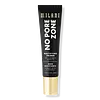What's inside
What's inside
 Key Ingredients
Key Ingredients

 Benefits
Benefits

 Concerns
Concerns

 Ingredients Side-by-side
Ingredients Side-by-side

Dimethicone
EmollientDisiloxane
Skin ConditioningIsononyl Isononanoate
EmollientDimethicone Crosspolymer
Emulsion StabilisingHdi/Trimethylol Hexyllactone Crosspolymer
Silica
AbrasiveLilium Candidum Leaf Cell Extract
Skin ConditioningBambusa Arundinacea Stem Extract
Skin ConditioningSilica Dimethyl Silylate
EmollientGlycerin
HumectantSodium Hyaluronate
HumectantTocopherol
AntioxidantEthylhexyl Palmitate
EmollientButylene Glycol
HumectantCaprylyl Glycol
EmollientHexylene Glycol
EmulsifyingPhenoxyethanol
PreservativeEthylhexylglycerin
Skin ConditioningDimethicone, Disiloxane, Isononyl Isononanoate, Dimethicone Crosspolymer, Hdi/Trimethylol Hexyllactone Crosspolymer, Silica, Lilium Candidum Leaf Cell Extract, Bambusa Arundinacea Stem Extract, Silica Dimethyl Silylate, Glycerin, Sodium Hyaluronate, Tocopherol, Ethylhexyl Palmitate, Butylene Glycol, Caprylyl Glycol, Hexylene Glycol, Phenoxyethanol, Ethylhexylglycerin
Water
Skin ConditioningSilica
AbrasivePropanediol
SolventNylon-11
Pentylene Glycol
Skin ConditioningNiacinamide
SmoothingPolyglyceryl-10 Diisostearate
EmulsifyingDicaprylyl Ether
EmollientCorn Starch Modified
AbsorbentBakuchiol
AntimicrobialParfum
MaskingHamamelis Virginiana Water
AstringentButyrospermum Parkii Butter Unsaponifiables
Skin ConditioningLens Esculenta Seed Extract
Skin ProtectingShorea Robusta Seed Butter
EmollientCoffea Arabica Seed Oil
MaskingGlycine Soja Oil
EmollientTocopherol
AntioxidantMoonstone Powder
Skin ConditioningGlyceryl Undecylenate
EmollientEthyl Stearate
EmollientEthyl Palmitate
EmollientEthyl Oleate
EmollientEthyl Linoleate
EmollientAcrylates/Beheneth-25 Methacrylate Copolymer
Ethyl Macadamiate
Skin ConditioningMalic Acid
BufferingSodium Carbomer
Emulsion StabilisingSaccharide Isomerate
HumectantSodium Hyaluronate
HumectantSodium Hydroxide
BufferingTrisodium Ethylenediamine Disuccinate
Ethylhexylglycerin
Skin ConditioningGlyceryl Caprylate
EmollientPhenoxyethanol
PreservativeLinalool
PerfumingWater, Silica, Propanediol, Nylon-11, Pentylene Glycol, Niacinamide, Polyglyceryl-10 Diisostearate, Dicaprylyl Ether, Corn Starch Modified, Bakuchiol, Parfum, Hamamelis Virginiana Water, Butyrospermum Parkii Butter Unsaponifiables, Lens Esculenta Seed Extract, Shorea Robusta Seed Butter, Coffea Arabica Seed Oil, Glycine Soja Oil, Tocopherol, Moonstone Powder, Glyceryl Undecylenate, Ethyl Stearate, Ethyl Palmitate, Ethyl Oleate, Ethyl Linoleate, Acrylates/Beheneth-25 Methacrylate Copolymer, Ethyl Macadamiate, Malic Acid, Sodium Carbomer, Saccharide Isomerate, Sodium Hyaluronate, Sodium Hydroxide, Trisodium Ethylenediamine Disuccinate, Ethylhexylglycerin, Glyceryl Caprylate, Phenoxyethanol, Linalool
Ingredients Explained
These ingredients are found in both products.
Ingredients higher up in an ingredient list are typically present in a larger amount.
Ethylhexylglycerin (we can't pronounce this either) is commonly used as a preservative and skin softener. It is derived from glyceryl.
You might see Ethylhexylglycerin often paired with other preservatives such as phenoxyethanol. Ethylhexylglycerin has been found to increase the effectiveness of these other preservatives.
Phenoxyethanol is a preservative that has germicide, antimicrobial, and aromatic properties. Studies show that phenoxyethanol can prevent microbial growth. By itself, it has a scent that is similar to that of a rose.
It's often used in formulations along with Caprylyl Glycol to preserve the shelf life of products.
Silica, also known as silicon dioxide, is a naturally occurring mineral. It is used as a fine, spherical, and porous powder in cosmetics.
Though it has exfoliant properties, the function of silica varies depending on the product.
The unique structure of silica enhances the spreadability and adds smoothness, making it a great texture enhancer.
It is also used as an active carrier, emulsifier, and mattifier due to its ability to absorb excess oil.
In some products, tiny microneedles called spicules are made from silica or hydrolyzed sponge. When you rub them in, they lightly polish away dead skin layers and enhance the penetration of active ingredients.
Learn more about SilicaSodium Hyaluronate is hyaluronic acid's salt form. It is commonly derived from the sodium salt of hyaluronic acid.
Like hyaluronic acid, it is great at holding water and acts as a humectant. This makes it a great skin hydrating ingredient.
Sodium Hyaluronate is naturally occurring in our bodies and is mostly found in eye fluid and joints.
These are some other common types of Hyaluronic Acid:
Learn more about Sodium HyaluronateTocopherol (also known as Vitamin E) is a common antioxidant used to help protect the skin from free-radicals and strengthen the skin barrier. It's also fat soluble - this means our skin is great at absorbing it.
Vitamin E also helps keep your natural skin lipids healthy. Your lipid skin barrier naturally consists of lipids, ceramides, and fatty acids. Vitamin E offers extra protection for your skin’s lipid barrier, keeping your skin healthy and nourished.
Another benefit is a bit of UV protection. Vitamin E helps reduce the damage caused by UVB rays. (It should not replace your sunscreen). Combining it with Vitamin C can decrease sunburned cells and hyperpigmentation after UV exposure.
You might have noticed Vitamin E + C often paired together. This is because it is great at stabilizing Vitamin C. Using the two together helps increase the effectiveness of both ingredients.
There are often claims that Vitamin E can reduce/prevent scarring, but these claims haven't been confirmed by scientific research.
Learn more about Tocopherol